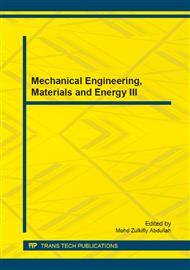[1]
E. Brinksmeier, J.C. Aurich, E. Govekar, C. Heinzel, H. -W. Hoffmeister, J. Peters, R. Rentsch, D.J. Stephenson, E. Uhlmann, K. Weinert and M. Wittmann: CIRP Annals-Manufacturing Technology 55(2) (2006), pp.667-696.
DOI: 10.1016/j.cirp.2006.10.003
Google Scholar
[2]
C. Su, J. Hou, L. Zhu, and W. Wang: Journal of System Simulation 19 (2008): 045, pp.5250-5253.
Google Scholar
[3]
D.A. Doman, R. Bauer, and A. Warkentin: Proceedings of the Institution of Mechanical Engineers, Part B: Journal of Engineering Manufacture 223(12) (2009), pp.1519-1527.
DOI: 10.1243/09544054jem1520
Google Scholar
[4]
T.T. Öpöz, X. Chen: Proceedings of the 8th International Conference on Manufacturing Research, 14-16 Sept 2010, Durham, UK.
Google Scholar
[5]
T.T. Öpöz, X. Chen: Proceedings of the 16th International Conference on Automation & Computing, 11 Sept 2010, Birmingham, UK.
Google Scholar
[6]
T.T. Öpöz, X. Chen: Proceedings of the International Conference on Advances in Materials and Processing Technologies (AMPT2010), 1315 (1), pp.1467-1472.
Google Scholar
[7]
D. Anderson, A. Warkentin, and R. Bauer: Int. J. of Machine Tools and Manufacture 51(12) (2011), pp.898-910.
Google Scholar
[8]
M.F. Villumsen, T.G. Fauerholdt: LS-DYNA. Anwenderforum, Bamberg (2008), pp.17-36.
Google Scholar
[9]
C. Espinosa, J.L. Lacome, J. Limido, M. Salaun, C. Mabru and R. Chieragatti: Proceedings of the 10th International LS-DYNA Users Conference, Dearborn, Michigan. (2008).
Google Scholar
[10]
Ruttimann, Niklaus, Sebastian Buhl, and Konrad Wegener: J Mach Eng 10 (2010), pp.17-29.
Google Scholar
[11]
C. Su, L. Xu, M.G. Li, and J.J. Ma: Acta Aeronautica & Astronautica Sinica, 33 (11) (2012), pp.2130-2135.
Google Scholar
[12]
J.O. Hallquist: LS-DYNA's Theoretical Manual, LSTC, Livermore, (2006).
Google Scholar
[13]
M. Jutras: Dissertation, Université Laval, (2008).
Google Scholar
[14]
C. Li, S. Xiu and G. Cai: Diamond & Abrasives Engineering 4 (2004), pp.16-20.
Google Scholar
[15]
J. Wang, R. Ye, Y. Tang and H. Bin: Diamond &Abrasives Engineering5 (2009), pp.41-45.
Google Scholar


